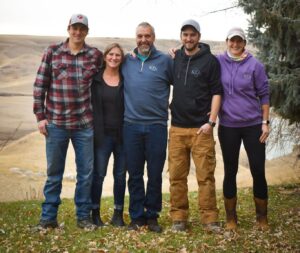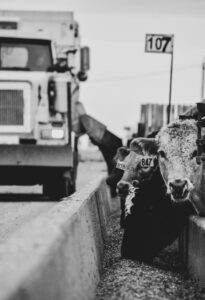Taking Pain Management Mainstream -- Producers Add Pain Medication to Their Routines and Benefit Their Herds
Pain management for beef cattle has evolved significantly in the past two decades. Scientists have gained a greater understanding of what pain looks like in an animal and how reducing pain can affect an animal’s well-being.
The beef industry has also responded, with the advent of user-friendly, cost-effective pain medications as well as veterinary teams and producers skilled at implementing effective pain mitigation.
“More veterinarians and producers are recognizing pain in cattle, and we now have a multitude of tools such as nonsteroidal anti-inflammatory (NSAIDs) drugs like Flunixin, Ketoprofen, and Meloxicam, and local anesthesia, such as lidocaine blocks, that we can use to better manage pain,” explains Dr. Jennifer Pearson, DVM, Ph.D. Pearson, a professor at the University of Calgary’s Faculty of Veterinary Medicine (UCVM), studies cow-calf health and reproductive management, including pain mitigation.
“With new information about how to better manage pain in cattle, we can make appropriate management decisions to mitigate the health losses associated with pain such as illness and loss of production,” says Pearson.
Pain management drugs, like NSAIDs, require a veterinary prescription. Today, more producers than ever are talking to their veterinarians to discuss pain relief options to help their herds withstand routine painful procedures like castration. As well, the use of pain medication is increasingly part of a producer’s toolbox for treating pain during relatively commonplace events, such as calving or calf sickness.
In 2014, just over 4% of beef producers surveyed indicated they were controlling pain during castration. By 2017, up to 28% of producers reported using pain medication.
Source: Adoption Rates of Recommended Practices by Cow-Calf Operators in Canada, 2019
Delivery Discomfort

Pain in beef cattle is often thought of in the context of tissue damage, such as castration, injury, lameness or surgery, Pearson says. Inflammation from diseases like scours or pneumonia can also cause discomfort. Although calving is a natural process, it can be painful as well. Cows and calves that withstand a difficult delivery may benefit from pain management.
“Very few studies have looked at the implementation of pain medications in beef cows and calves after a difficult birth,” says Pearson. “Our research at UCVM has shown that calves that receive Meloxicam after a difficult calving gain more weight in the first week of life compared to calves that received a placebo (no medication),” she explains. She adds that preliminary findings from a recent field trial also showed that calves receiving Meloxicam after a difficult calving expressed more play behaviour and were more active, compared to their counterparts that received the placebo.
“Currently, we are recommending pain medication to be given to cows and calves after a difficult calving, but more research is needed to better understand how this pain medication can mitigate other negative effects of pain in cows and calves,” Pearson describes.
Pearson says there haven’t been any studies that investigate the economic benefit of using pain medication for a difficult calving, but when speaking with producers she finds they are more than willing to reduce pain or suffering with a quick dose of pain drugs as an act of good stewardship. The cost of the medication doesn’t appear to be a barrier to its use, Pearson observes.
Cow-Calf Care
Garrett Wolf raises cattle with his wife Jacquelyn near Spruce View, Alberta. On their farm, managing pain is simply a part of what they do when processing calves in the springtime or when treating a sick animal.
“We’re not really doing anything crazy, it’s become a practice that we do every year that makes sense for us,” Wolf says. “Our vet got a lot of people into it,” he explains, adding that they started using it on a trial basis about four or five years ago and kept it up. “It’s just so dirt cheap compared to everything else.”
At spring processing, in addition to tagging and vaccinating his calves, Garrett surgically castrates his steer calves, giving them a dose of oral Meloxicam to help manage pain. “Anyone can administer it, it’s less invasive than a needle,” he says.
For producers looking for strategies to manage pain in their herds, the first step is to ensure they have a valid veterinary-client-patient relationship. Veterinarians can provide insight and guidance that is specific to a farm’s unique needs.
If he has to treat calves for sickness, such as scours, Wolf consults his veterinarian to determine if there is an opportunity to include pain management. “Anytime we treat a calf, it’s in pain of some kind,” he explains.
He finds the cost of pain medication to be relatively affordable. “The pain management isn’t a miracle cure but it’s quite apparent it helps,” he says. “If it helps a little bit, it’s worth it, especially for the price,” Garrett concludes.
“Return-on-investment aside, it’s the right thing to do.”
— Garrett Wolf, beef producer from Spruce View, Alberta
Remember Pain Relief When Treating Foot Rot
Dr. Jacques van Zyl, DVM, a beef veterinarian with Ontario-based Metzger Veterinary Services, says pain management is standard practice for him. Most clients are open to using NSAIDs, he says, and adding a pain control product to a treatment protocol for diseases such as foot rot is manageable.

“Foot rot is painful, we do know that,” he says.
The only product labeled for managing pain due to foot rot is pour-on Banamine. “Anything pour-on needs to be absorbed through the skin,” van Zyl explains, noting that there is room for error with administration. “It must be applied to the skin, not just poured on top of the hair. Improper application is a common issue for failure to respond to treatment,” he says.
Van Zyl acknowledges that pour-on products, particularly in pasture situations, may not be practical for producers to apply. He recommends producers contact their vets for other available pain control options that might be feasible.
He points out lameness can have several causes and getting an early and accurate diagnosis is key. Veterinarians should lift the foot and inspect the area for swelling, redness, and other signs of infection to rule out injury or a foreign object embedded in the foot that could otherwise cause pain.
“You have to be sharp on the follow-up and look at treatment success rates,” he says, noting that the bacteria causing foot rot, Fusobacterium necrophorum, typically responds to antibiotics very quickly.
Van Zyl says that there has been an increase in combination drugs that work to manage both pain and infection. “I think that might indicate a change in the market, guys want to give something for a reduction of fever but don’t want to give two needles, so there are more options available that are a one-shot deal,” he explains.
“Getting more products on label for pain management is the biggest thing,” van Zyl says.
Feedlot Finds Pain Management a Worthwhile Venture
Experienced Alberta feedlot operator Leighton Kolk has seen a transition in the approach toward cattle care that includes a willingness to incorporate pain management.

Leighton, who is the CEO of Kolk Farms, based out of Iron Springs, Alberta, has seen the industry prioritize stress reduction and pain management in beef cattle.
“I guess it’s two-fold,” he explains. “One is recognizing the importance of pain management and the second is then actually having something that we can use,” Kolk says. Having the philosophy that managing pain is worthwhile goes hand-in-hand with producers gaining access to user-friendly products.
“It’s nice to have a $6 [per head] treatment and we know it works,” Kolk says.
His pain control go-to is oral Meloxicam. “It’s very economical and easy to use and works really well, we use that for everything,” Kolk explains but adds that Meloxicam has a 35-day pre-slaughter withdrawal period. He has a few other options if animals are getting close to their harvest date. “[Injectable] Metacam works well too and has a 20-day withdrawal,” he explains. Anafen is another pain drug that has a much narrower one-day withdrawal window.

As prey animals, cattle tend to hide the fact that they are in pain, so the Kolks don’t wait for an animal to show signs of discomfort before they administer pain medicine. “We don’t like to display pain if we don’t have to, and neither do cattle,” he says. They use pain drugs for castrations, prolapses and just about any condition that might potentially cause a feedlot animal pain.
For lameness, they will also use pain control strategies but first diagnose the underlying cause. “We will use it usually in conjunction in picking up a foot or looking for that injury or rock stuck in their hoof or a toe abscess,” he explains.
Managing pain is important for staff morale as well. “One thing about our staff, is they do the job because they care about the animal and when they can see an animal that is comfortable, they feel better about their job,” Leighton says.
“I feel better and can hold my head up proud knowing I’m not causing distress and the side benefit is the cattle perform better,” he explains. “So often in livestock agriculture, doing the right thing seems to almost always be the right thing economically. The big win I see is with animal comfort,” he concludes.
While pain management is still advancing, producers, scientists, veterinarians and pharmaceutical companies are working together to develop practical, effective pain management solutions.
Learn More:
- Pain Mitigation in Beef Cattle (BCRC topic page)
- Canada’s Code of Practice for the Care and Handling of Beef Cattle (National Farm Animal Care Council)
- Can We Reduce Castration Pain in Week-Old Calves? (BCRC post)
- Pain, Pain, Go Away (BCRC post)
- That’s Gotta Hurt (BCRC post)
- Feeling Better About Castration (BCRC post)
- Practical and Effective Methods of Pain Control (BCRC webinar)
- Production Practices on Cow-Calf Operations (BCRC post)
Le partage ou la réimpression des articles du blog du BCRC est bienvenu et et encouragé. Veuillez mentionner le Conseil de recherche sur les bovins de boucherie, indiquer l’adresse du site web, www.BeefResearch.ca/fr, et nous faire savoir que vous avez choisi de partager l’article en nous envoyant un courriel à l’adresse info@beefresearch.ca.
Vos questions, commentaires et suggestions sont les bienvenus. Contactez-nous directement ou suscitez une discussion publique en publiant vos réflexions ci-dessous.
